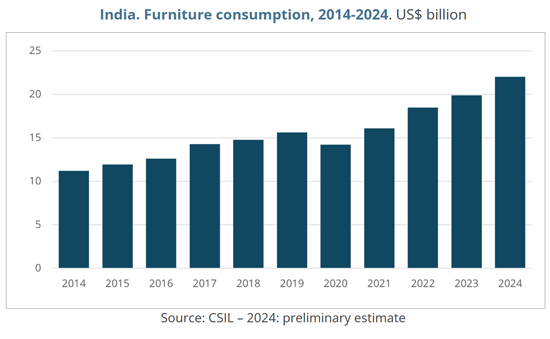|
|
市場調査レポート
商品コード
1695947
インドの家具産業The Furniture Industry in India |
||||||
|
|||||||
| インドの家具産業 |
|
出版日: 2025年03月31日
発行: CSIL Centre for Industrial Studies
ページ情報: 英文 87 Pages
納期: 即日から翌営業日
|
全表示
- 概要
- 目次
当レポートは、主要指標、市場力学、需要促進要因、生産要素、インドの主要家具製造業者に関する情報などを通じて、インドの家具産業に関する最新かつ詳細な分析を提供しています。
インドの家具市場:主要指標と基本データ
当レポートでは、2014年から2024年までの家具の製造量、消費量、輸入量、輸出量、2025年と2026年の家具市場予測など、主な指標と基礎データの概要を通してインドの家具セクターを分析しています。また、インドの家具市場を主な需要決定要因から探り、セグメント別 (布張り家具、キッチン家具、オフィス家具、寝室・ダイニング・リビング用家具、その他家具) に分類しています。家具産業に関しては、製造額をセグメント別に分類し、主な生産要素も示しています。家具の製造と消費に加えて、本レポートはインドの家具貿易、輸出入についても分析し、そのダイナミクス、原産国、輸出先市場についても考察しています。
インドの家具市場:競合情勢
本レポートでは、インドの家具市場の競合情勢についても掘り下げており、その構造を説明し、約80社の情報を網羅しています。家具売上高上位50社については、以下の詳細なプロファイルを掲載しています。
- 企業名
- 本社所在地
- グループ
- 活動内容
- 製品ポートフォリオ
- 売上高と従業員数 (最終年度)
- 総売上高に占める輸出の割合
- 製造施設
インドの家具市場:流通
本レポートでは、インドの家具流通システム、チャネル、小売についても説明し、インドで事業活動を展開する欧州の家具製造業者とインドの家具小売業者 (ウェブサイトと都市名) の情報を提供しています。約150の家具小売業者のリストには、以下の情報が含まれています。
- 企業名
- ウェブサイト
- 都市名
ハイライト

インドの家具市場の市場規模は約220億米ドルで、過去10年間でほぼ倍増し、世界で第4位、アジア太平洋地域では中国に次いで第2位に位置付けています。インドは2025年と2026年に予測される家具市場でももっとも急成長する市場のひとつであり、中間層の拡大、住宅・商業インフラへの投資の増加、政府の取り組み、家具小売の近代化などがその要因となっています。
インドの家具市場は大きな変革期を迎えており、高度に細分化された非組織的構造から、より統合された競合情勢へと移行しつつあります。急速な都市化、可処分所得の増加、世界的な統合が産業を再構築し、効率化を促進しています。国際的ブランドの参入、組織小売の拡大、市場統合の進展が、この変化を加速させています。
目次 (要約)
第1章 インドの家具業界の主要データ
第2章 インドの家具市場の可能性
- インドの家具消費、経済環境の予測、家具市場の予測
第3章 需要の決定要因
第4章 家具消費の動向とセグメント別の家具消費
第5章 家具の輸入
- インドの家具輸入と家具消費
- 輸入・消費比率:セグメント別
- インドの家具輸入の主な原産国
- 家具輸入と家具輸入元:セグメント別
- 家具部品の輸出入
第6章 インド:生産要素
第7章 家具製造の動向とセグメント別家具製造
第8章 家具の輸出
- インドの家具輸出と家具製造
- 輸出/製造比率:セグメント別
- 家具輸出の主な相手国
- 家具輸出と家具輸出先:セグメント別
第9章 インドの家具市場の競合システムの分析と説明
- 総売上高による家具製造業者上位50社
- その他のインドの家具製造業者
第10章 インドで事業を展開する大手家具製造業者50社のプロファイル
第11章 インドの流通チャネルと小売
- インドで事業を展開する欧州の主要家具企業:流通チャネル
- インドの主要家具小売業者:ウェブサイト・都市
付録 (国別ランキング、社会経済データ、家具市場データ、家具の輸出入)
手法に関する注記
CSIL's Research Report "The furniture industry in India" offers an up-to-date and detailed analysis of the Indian furniture sector, through key indicators, market dynamics, demand drivers, productive factors, and information about the leading furniture manufacturers in India.
An executive summary introduces the study describing the role of India within the global furniture industry and the main factors driving the country's development and the increase in furniture demand, with CSIL's assessment of market potential and challenges.
INDIA FURNITURE MARKET: KEY INDICATORS AND BASIC DATA
The furniture sector in India is analysed through an overview of the main indicators and basic data: values of production, consumption, imports, and exports of furniture for the time series 2014-2024, and furniture market forecasts for 2025 and 2026.
The Indian furniture market is also explored through the main demand determinants and broken down by segment (upholstered furniture; kitchen furniture, office furniture; bedroom, dining and living room furniture; other furniture).
As far as the furniture industry is concerned, the value of production is broken down by segment and the main productive factors are also provided.
In addition to furniture production and consumption, the report also analyses the Indian furniture trade, imports and exports, with insights into dynamics, countries of origin, and destination markets.
THE COMPETITIVE LANDSCAPE OF THE INDIAN FURNITURE MARKET
This report also delves into the Indian furniture competitive system, describing its structure and covering information for about 80 companies.
For the top 50 Indian furniture manufacturers by furniture turnover, it offers detailed profiles including:
- Company name
- Headquarters
- Group
- Activity
- Product Portfolio
- Turnover and number of employees (last available year)
- Exports share on total turnover
- Manufacturing facilities
The competition analysis also offers information on other Indian large furniture manufacturers, with Company name, Web, e-mail address, Activity, Turnover range, Product Portfolio, and Location.
FURNITURE DISTRIBUTION IN INDIA
The study also describes the Indian furniture distribution system, channels, and retail, and provides information for selected European furniture companies with business activity in India and furniture retailers in India (website and city).
A list of about 150 furniture retailers is provided including the following information: company name, website, city
ANNEXES
Annexes containing socio-economic data, furniture market forecasts, trade figures, and methodological notes complement the analysis.
CSIL's Research Report 'The furniture industry in India' is part of the Country Furniture Outlook Series, that currently covers 100 markets.
Highlights:

With a value of around USD 22 billion, the furniture market in India nearly doubled in the last ten years, making it the world's fourth-largest and the second-largest in the Asia-Pacific region, after China. India is also among the fastest-growing furniture markets projected for 2025 and 2026, driven by an expanding middle class, rising investments in residential and commercial infrastructure, government initiatives, and the modernisation of furniture retail.
The Indian furniture market is undergoing a significant transformation, shifting from a highly fragmented and unorganised structure to a more consolidated and competitive landscape. Rapid urbanisation, increasing disposable incomes, and global integration are reshaping industry, and fostering efficiency. The entry of international brands, the expansion of organised retail, and growing market consolidation are accelerating this shift.
TABLE OF CONTENTS (ABSTRACT)
1. Key Facts of the Furniture Sector in India
2. The potential of the Indian furniture market
- Furniture consumption in India, economic environment forecasts and furniture market forecasts
3. Demand Determinants
4. Furniture Consumption trends and and Furniture consumption by segment
5. Furniture Imports
- India's Furniture imports and furniture consumption
- Imports/consumption ratio by segment
- Main countries of origin of Indian furniture imports
- Furniture imports by segment and sources of furniture imports by segment
- Imports and exports of furniture parts
6. India. Productive Factors
7. Furniture Production trends and Furniture production by segment
8. Furniture Exports
- India's Furniture exports and furniture production
- Exports/production ratio by segment
- Main countries destination for furniture exports
- Furniture exports by segment and destination for furniture exports by segment
9. Analysis and description of the competitive system of the furniture market in India
- Top 50 furniture manufacturers by total turnover (Company, Group, Total Turnover, Product portfolio and Location)
- Other Indian furniture manufacturers (Company, Web, Activity, Turnover range, Product Portfolio, Location)
10. Profiles of a sample of 50 leading furniture manufacturers operating in India
11. Distribution channels and retail in India
- Selection of European furniture companies with business activity in India: distribution channels
- Selection of furniture retailers in India: website and city

